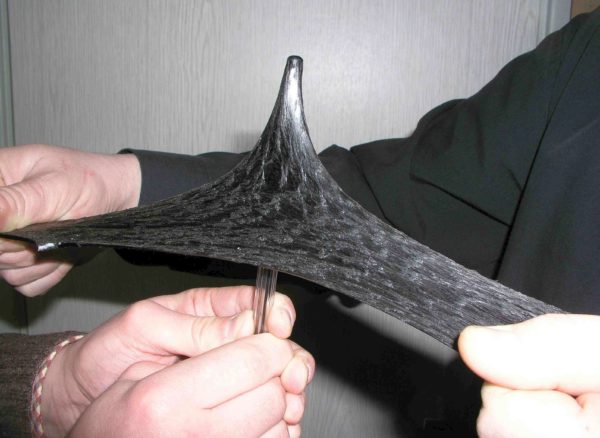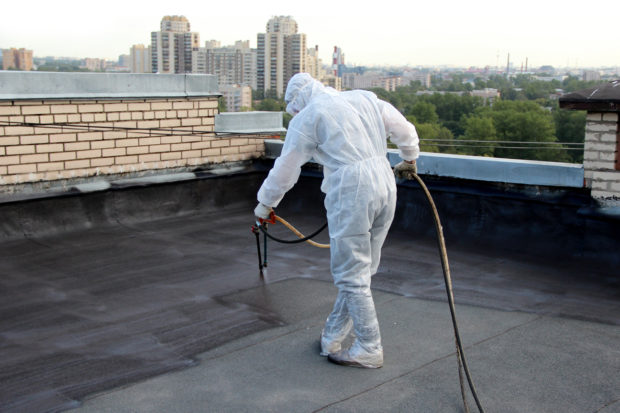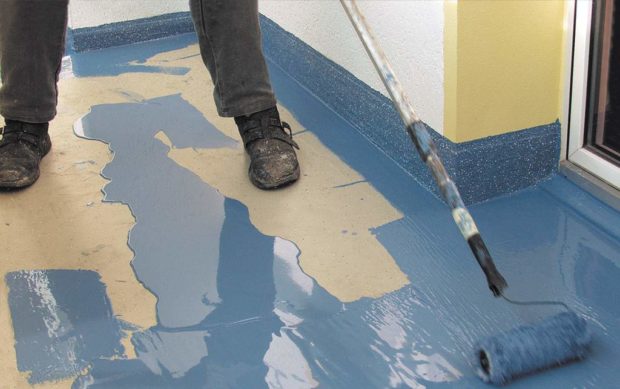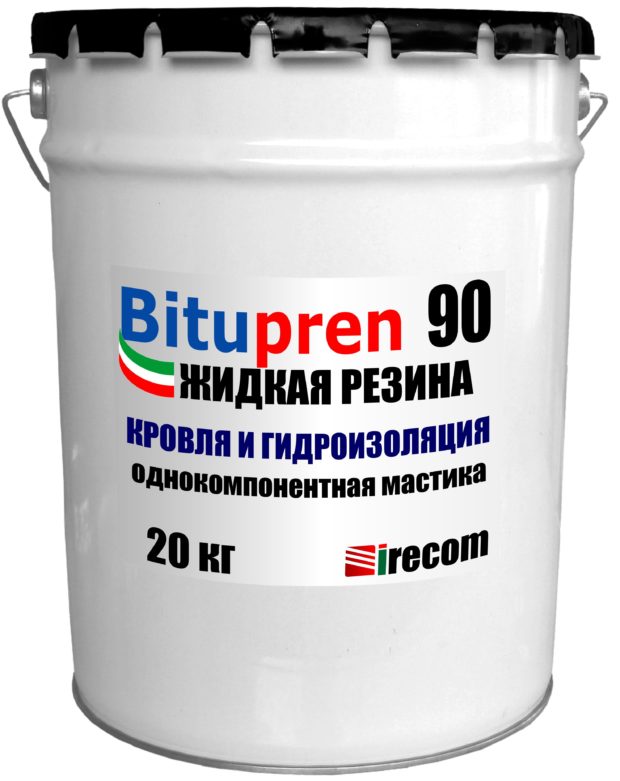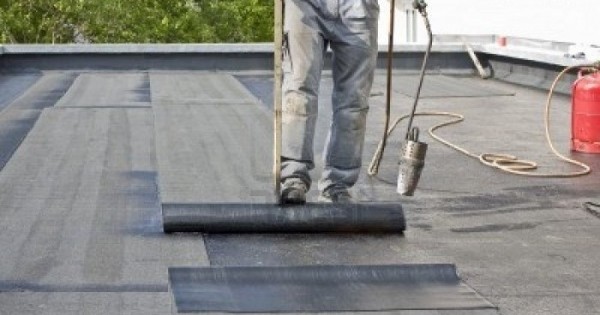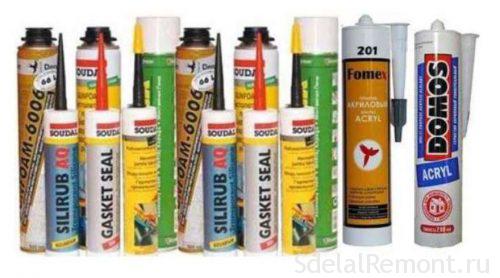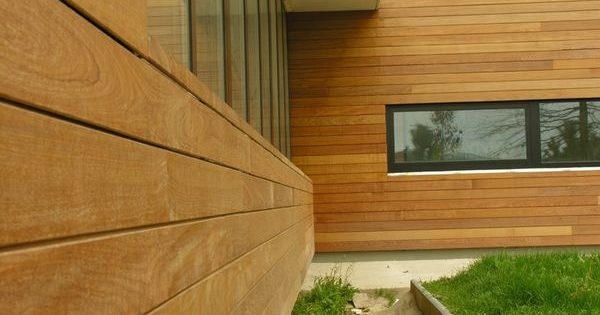Liquid rubber for waterproofing: 9 tips for choosing and using
Without holding waterproofing works it is difficult to imagine the construction of a house and a garage, not to mention more serious facilities. While in this area roll materials dominate, which are called optimal in terms of characteristics and ease of use. But are they really that good? Definitely they are not bad, but recently something more modern and effective has appeared on the market. This is liquid rubber, or, to be extremely precise, a seamless sprayable waterproofing. It is gradually gaining the sympathy of both professional builders and home craftsmen, and it can be used in a host of different areas. So, let's try to figure out why liquid rubber is so good for waterproofing the roof, foundation, pools and other objects and surfaces, what it happens and how it is applied.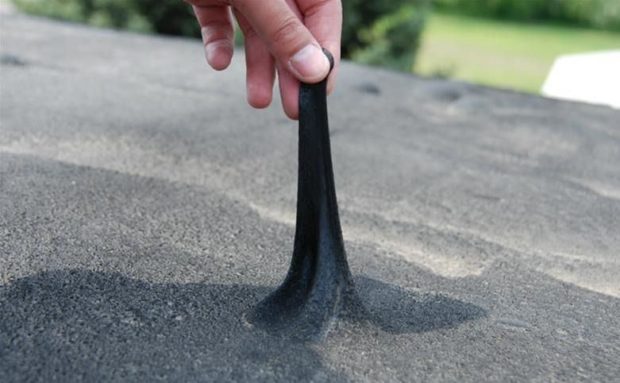
No. 1. What is liquid rubber?
Liquid rubber recently appeared on the market of waterproofing materials, so not many people know what this coating is made of. Let's begin with the material has nothing to do with ordinary rubber. If rubber familiar to all of us is made on the basis of rubber, then liquid rubber is a product of bitumen processing. Latex and other modifying additives, stabilizers, polymers and water are added to it. The result is a two-component system, an emulsion, the properties of which allow it to be used for high-quality waterproofing. Only black color unites it with ordinary rubber and the ability to self-repair after minor damage, punctures, deformations - according to this indicator, the material bypasses all traditional rolled analogues.
It is more correct to call the material sprayed seamless waterproofing, but this name did not take root among buyers, apparently due to excessive complexity. Many manufacturers insist on the same name, but the concept of liquid rubber continues to be used in the domestic market. By the way, they tried to produce something similar in the USSR in the 70s, but the quality of bitumen raw materials was low, so the material was not widely used.
Liquid rubber does not pass water at all, which is largely ensured by the complete absence of seams. That is why the material is actively used in waterproofing foundations, roofs, pools, basements, ponds, bridges, as well as for anti-corrosion treatment.
No. 2. Advantages and disadvantages
We will not loudly declare that liquid rubber is an ideal and universal material, but we note that he, in fact, many advantages:
- opportunity to get monolithic waterproofing without joints and seams, namely they often fail sufficiently high-quality and resistant rolled materials;
- high adhesion to all kinds of surfaces. Liquid rubber can be applied to concrete, wood and metal, and the base may be slightly wet;
- liquid glass not afraid of temperature changes (withstands temperatures from -450C to +800C), sunlight and, of course, precipitation. Specially designed types of liquid rubber withstand up to -700FROM;
- material penetrates deep into pores and crevices, contributing to the formation of a reliable barrier to moisture and other negative environmental factors. True, the best degree of penetration can be achieved by using sprayed liquid rubber;
- elasticity and the ability to return to previous sizes. Easy to surface minor scratches and other defects are tightened. All this means that humidity, temperature changes and mechanical stress are not able to cause great harm to the coating. If the waterproofing is made of inelastic material, then under the influence of temperature changes from summer heat to winter cold, cracks appear on the material in a few years, and this is the way for moisture to penetrate. Liquid rubber tends to increase with increasing temperature, but it does not lose its integrity;

- as part of the material no toxic substances, therefore, its application and operation are completely safe. You can use this waterproofing even in unventilated rooms;
- you can apply liquid rubber both manual and mechanized. The latter option is attractive in that all the work can be done as soon as possible and at the same time to qualitatively cover the most complex elements (protruding roof parts, pipes, etc.);
- the installation process does not require the use of additional heating equipment, but nevertheless, for a qualitative result, you will have to use certain equipment, and even better - turn to the services of professionals;
- when using special equipment is achieved highest installation speed. For example, to execute roof waterproofing area of 800 m2 roll material, it will take about 14 days. With liquid rubber you can cope in just 2 days;
- liquid rubber can be applied in several different ways, so you can always choose the most suitable option;
- the classic color of liquid rubber is black, but it has other shades of material on sale, so with it you can realize almost any idea;
- when the coating dries, almost any decorative material can be applied to it. If we are talking about the roof, this means that in the future it can be used to good use. Liquid rubber can be applied to all water-based paints;
- maintainability. In case of severe damage to the coating, it is quite simple to restore it, after local treatment with a new layer of liquid rubber;
- in most cases, spraying on an old waterproofing coating is allowed;
- multifunctionality. Due to the unique set of qualities, liquid rubber can be used not only for waterproofing, but also, for example, to create an anti-corrosion layer. As for the waterproofing itself, the material is suitable for indoor and outdoor use, as well as for spraying on a vertical surface;
- the raw materials are transported in barrels, it can be brought to the facility even in a passenger car (if we are talking about a small amount of raw materials).

Among the shortcomings, we note:
- a mechanized method of application is, of course, quick, but expensive - it will take special equipment, and often also specially trained people;
- the material itself cannot be called cheap - it more expensive than any roll waterproofing. On the other hand, if you take into account that you have to roll the rolls, sometimes even in two layers, warm them up, and this is also a time expense, then the price difference will not be so large;
- difficult dismantling. High adhesion, which makes the material so attractive, becomes the cause of extremely complex dismantling work. Will have to suffer much more than in the case of roll waterproofing. On the other hand, liquid rubber is rarely completely removed - usually it is enough to just repair the coating;
- material afraid of some solventscontaining petroleum products. Damage, although small, will be.You can get rid of them with the help of small repairs. It is rather difficult to imagine a situation when a shower of oil products falls over the entire roof.
If you have any questions, then the tables will help you make a complete impression of liquid rubber and compare it with other popular waterproofing materials.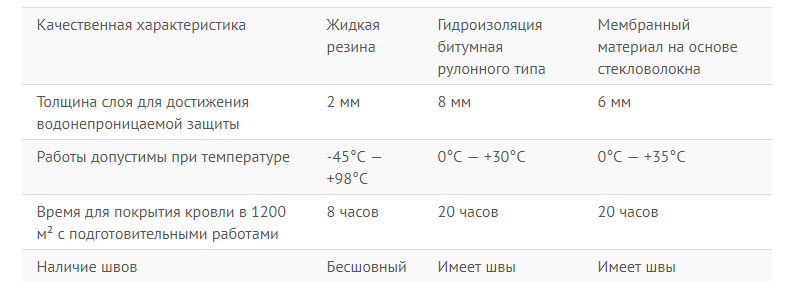
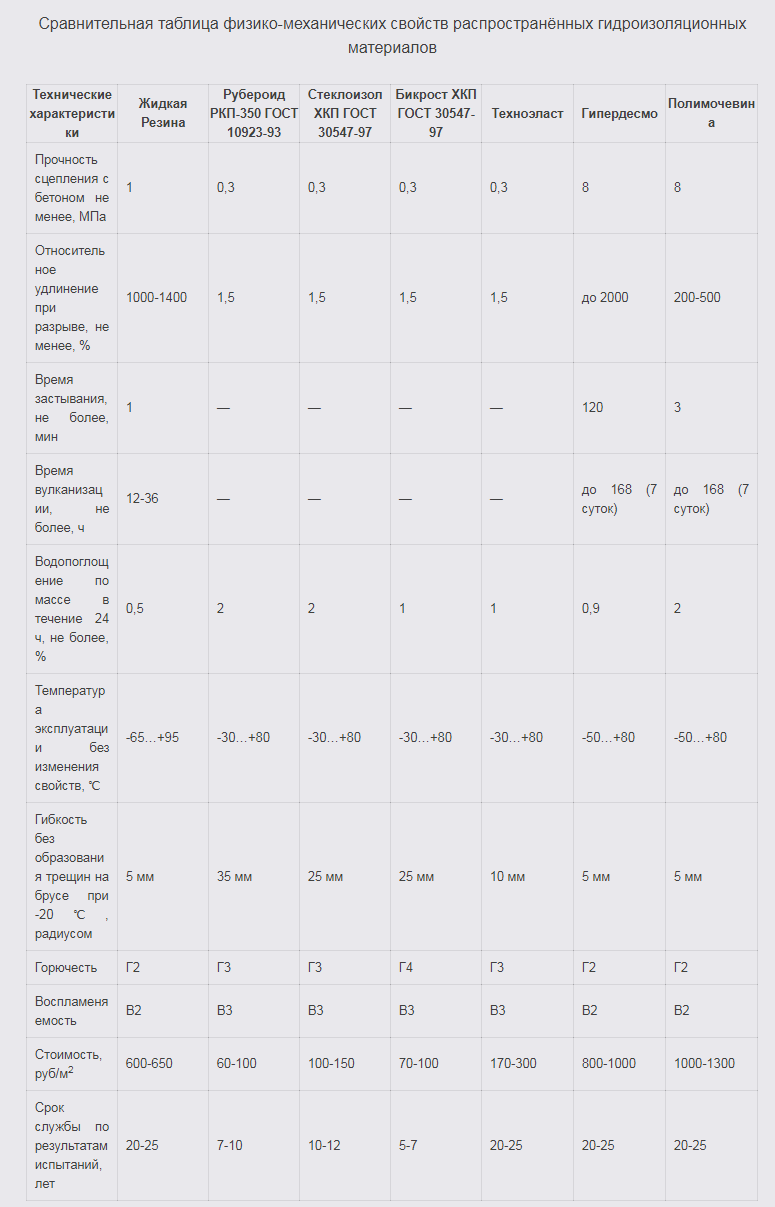
No. 3. Types of Liquid Rubber
Depending on the composition, liquid rubber may be:
- single component;
- two-component.
According to the manufacturers, single component formulations immediately ready for use. After opening the container, you just have to apply it to the surface with a roller or brush. There are formulations that are applied in several layers to achieve the required operational quality of the coating, and there are those that can be applied in just one layer. The latter, as a rule, are more expensive. One-component compositions must be used immediately - open packaging is not stored for a long time. They do not penetrate very deep into the pores of the insulated material, but in terms of use they are very convenient and do not require specific equipment. Great for places that will subsequently come into contact with moisture infrequently.
Two-componentand, if more correct, multicomponent mixtures consist of at least two components. It is the base and curing catalyst. The components are mixed immediately before application, and thanks to special spraying devices, such insulation penetrates deep into the pores of the material. With such mixtures professionals work.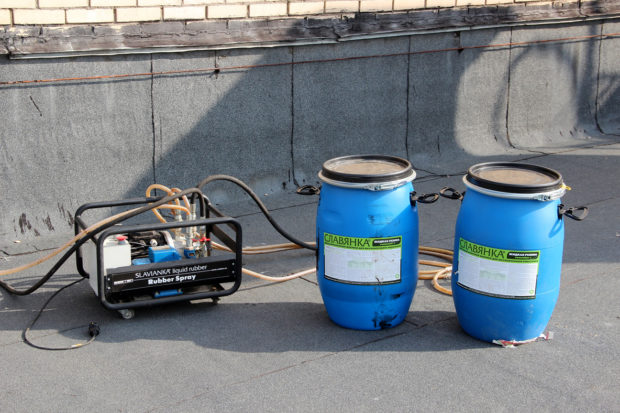
Number 4. The method of applying liquid rubber
The versatility of liquid rubber is evidenced by a variety of methods of its application. Depending on the installation technique, liquid rubber can be:
- sprayed. Application is by cold spraying using special equipment. As a result, it is possible to get the best quality coverage in the shortest possible time, but you will have to acquire special devices. Although this is the most expensive installation option, it is now the most popular;

- paint rubber applied manually using brushes, rollers, spatulas. The material has a liquid or pasty consistency, is characterized by a tendency to film formation;

- bulk rubber has the worst quality in terms of waterproofing. The material is prepared on site and, as the name suggests, is poured onto a horizontal surface (floor, foundation). Such material is the cheapest.

It makes no sense to purchase special equipment for personal use - it is better to contact professionals. As a rule, specialists use mobile dosing and mixing device, which does not require a connection to electricity - it runs on a gasoline engine. Long hoses (up to 150 m) allow you to apply liquid rubber to the most inaccessible places without shifting the equipment itself. When spraying, the material is distributed very evenly and economically, up to 2000 m can be processed per day2 surface (on 1 m2 it takes 1-3 kg of coating). Since preheating is not required, the process can be called fireproof. The absence of toxic substances in the composition allows you to work without personal protective equipment.
No. 5. Where is liquid rubber used?
The material is so unique that it has become widespread in many areas of construction and is sometimes used not even for its intended purpose. The ability to create a completely waterproof and seamless coating allowed the use of liquid rubber in the following areas:
- foundation waterproofing, ceilings, flat and sloping roofs, basements. The material will protect not only from moisture, but also from mold. Allowed indoor and outdoor use;
- waterproofing pools, fountains and ponds.That's where the increased load on building materials! Liquid rubber allows you to create a waterproofing layer that completely repeats the pool bowl. Moreover, the coating will withstand various kinds of mechanical influences;
- waterproofing ventilation outlets, as the material withstands vibration loads and high temperatures;
- waterproofing surfaces with complex terrain, where rolled materials are almost impossible to use;
- waterproofing of bridges, tunnels, road sections, and in this area only the most durable and reliable materials are used;
- pitched roof repair (tiled, slate, metal), installation and repair of roofs from rolled surfaced materials;
- application in very cold and very hot regions;
- creation of an anticorrosive layer on metal structures. If liquid rubber creates a coating that is not permeable to water, then corrosion cannot develop;
- sometimes stuff applied to wood to protect it from external factors;
- liquid rubber can be used as an independent roofing material.
Surely, in the near future the scope of application of liquid rubber will expand even more, but now this waterproofing material is considered the most modern due to the cold process and the creation of a seamless durable coating.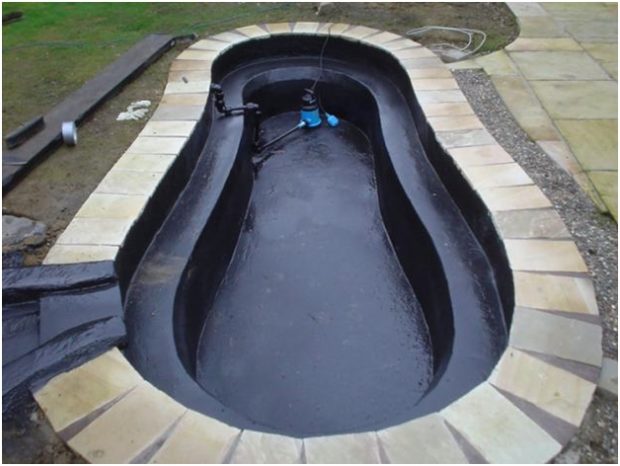
No. 6. Foundation waterproofing with liquid rubber
It is best to waterproof the foundation with liquid rubber even at the stage of building construction: it will be easier for you and the house will last longer. The sequence of work is as follows:
- clean the surface of dust and dirt, if necessary - degrease it;
- preferably applied to the surface primer;
- Liquid rubber can be applied to a damp surface, but if possible, it is better to work with a dry base. Work is recommended in dry weather;
- it is better to use a two-component mixture that is sprayed with equipment. If the foundation is small (for example, a barn or a gazebo), then you can apply one-component mixtures and manual application. The minimum coating thickness is 2 mm, but this indicator strongly depends on the depth of the foundation: up to 10 m a layer of 2-4 mm is enough, with a depth of 10-20 m a layer of 4-6 mm is needed;
- polymerization takes place during the day, then you can proceed with further work on the arrangement of the foundation.
If waterproofing is applied in the process of repairing the foundationthen you first have to prepare the surface. If the old waterproofing has already outlived its own, then it must be removed, otherwise it may further destroy the surface. If there are large defects, they can be aligned. Then the surface is prepared and waterproofed. After polymerization, you can proceed to warming, arranging drainage and backfilling with soil.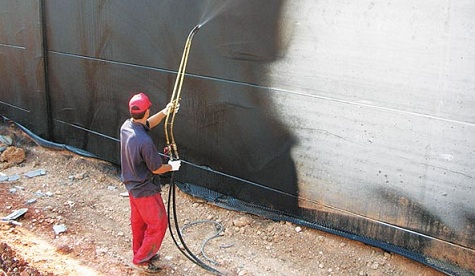
Number 7. Roof waterproofing with liquid rubber
The spraying method is best suited for arranging roof waterproofing - the equipment is mobile enough to seamlessly cover all the elements of the roof, even the most inaccessible and convex ones, with a material. It is better to work in dry weather at an air temperature of more than +50C. It is best to apply on a dry surface, but wet installation is not prohibited.
It is unlikely that someone will buy or rent equipment to do all the work on their own, but still it’s worth knowing the principle of work. This will help you to know exactly what specialists are doing on your roof and, in which case, ask them important questions.
The procedure is as follows:
- surface cleaning from dust and debris. The efficiency of this stage is increased by using a hydro-jet unit that delivers water under high pressure. The jet allows you to cope with fairly complex pollution. After that, the surface is dried and eliminated from greasy stains, if any. This is best done by burning;
- priming. Some experts skip this stage, but with it the coating is more durable and resistant.The first waterproofing layer is applied to the prepared base;
- directly spraying liquid rubber is carried out in strips of a width of 1-1.5 m, the distance between the surface and the working tool is about 40 cm;
- for the arrangement of the roof, usually 2-3 layers of liquid rubber are used, sometimes fiberglass or geotextiles are used between them;
- polymerization processes at a temperature of 20-250C completely completed in three days.
If there is no opportunity to hire specialists, then you can try to do everything manually. True, we advise you to stock up on time and patience in advance. Waterproofing is applied after preparatory work. The surface should be clean, nothing should fall off from it. In which case you have to use a cement-sand mixture. The solution is applied with a thickness of 3-4 mm. When the first layer is set, you can proceed to applying the next. After complete polymerization, you can proceed with the installation of the roofing material.
Do not be alarmed if, during drying, you find protruding droplets on the surface. This is a normal process, which is explained by the presence of a catalyst. When applying a waterproofing layer 2 mm thick liquid rubber consumption will be 3 liters per 1 m2, at 3 l - 4.5 l / m2and at 4 mm - about 6 l / m2.
Number 8. Roof repair with liquid rubber
Liquid rubber is used not only for waterproofing the roof, but also for repairing the existing waterproofing layer, and it can be made of any material. If the coating is worn out only in places, then it makes no sense to completely dismantle it. Damaged areas are removed, the bubbles are cut, and liquid rubber is applied to these places.
If the condition of the old waterproofing leaves much to be desired, then it is allowed to carry out a complete repair of the roof with the application of liquid rubber over the entire surface of the roof. It makes sense to do if there are a lot of damaged areas, but the material itself does not fall off.
No. 9. Liquid rubber manufacturers
It is easy to guess that the quality of waterproofing depends not only on the technique of work, but also on the characteristics of the material itself. Does it make sense to save money if the purchase of poor-quality material can damage the repair inside the house, and after a year or two it will be necessary to carry out the same work again, but using more expensive waterproofing? Probably not, so let's turn your attention to the largest manufacturers of liquid rubber. They value their reputation, so they are unlikely to sell low-quality goods.
- Liquid rubber (Canada) has production facilities in Belarus and Russia; it produces liquid rubber for waterproofing the foundation, roofing and protecting metal. The price is high, but consistent with the quality;
- Production company "Irek" (Russia) was formed in order to offer customers a domestic product that is cheaper than imported, but no less high-quality. Liquid rubber is available under the brand name Bitupren. There are one- and two-component compositions that are suitable for use in a variety of fields;
- Rastro (Russia) produces one- and two-component liquid rubber "Slav"characterized by a wide scope of use. Also in the assortment there are other waterproofing materials;
- GC Partner-Stroy (Russia) produces liquid rubber under trademarks "EUROMAST" and EUROMAST color (one-component), as well as EUROMAST plus (two-component);
- Cbs (Russia) produces universal and roofing liquid rubber, the assortment contains a material designed for use in arctic conditions “CBS Arctic Roofing”.

Promising material will allow you to forget about the problems of waterproofing for many years, if, of course, it was applied correctly, so do not save on the services of specialists - the avaricious pays twice, and at the same time suffers from his own avarice.

